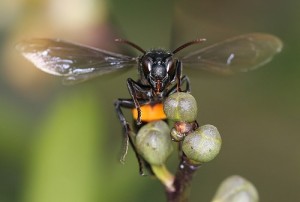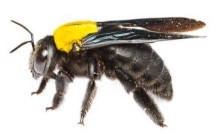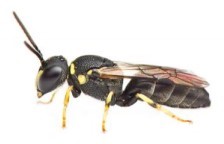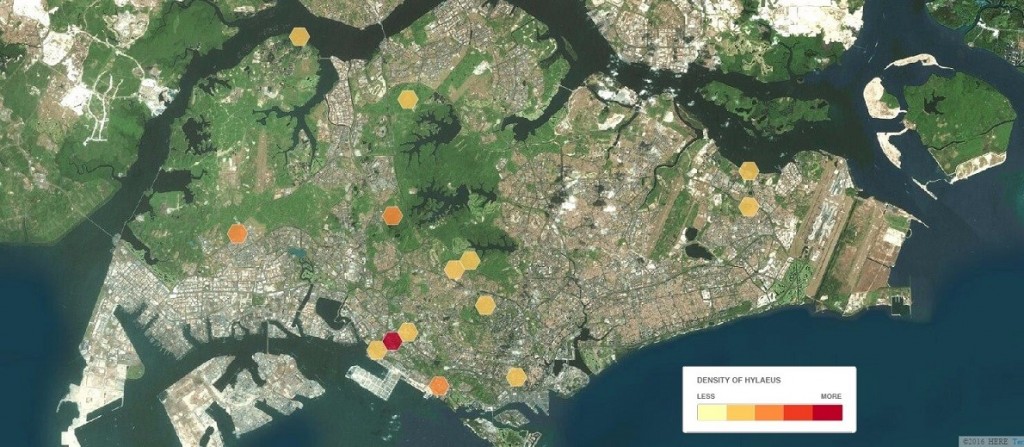In yesterday’s lecture, we had the privilege of listening to Dr John Ascher share more about bees in the city. Of all the new information gleaned, perhaps the most relevant one – to daily life, that is – we learnt was how to differentiate between a wasp and a bee: bees are usually [1] hairy, with broad hind legs and a tongue for sipping nectar, all of which wasps lack. Because most people are unable to tell the difference, bees are often misrepresented as dangerous creatures when in fact, it is wasps that are much more aggressive and lethal [2] – as natural predators, their streamlined bodies allow them to attack at much greater speeds and sting their prey multiple times, whereas bees are much slower and die after stinging once.

This Greater Banded Hornet (a social wasp) is the deadly one! (Photographed by Eddie Tan, 2012 )

The giant honey bee, Apis dorsata, also has a deadly sting (if you’re allergic), but don’t worry, it lives in the treetops so you’re not likely to spot it! (Photographed by Zestin Soh, in (Soh & Ngiam, 2013 [3])
On a more serious note, we also learnt why cities are important habitats for bees – they serve as a refuge from agricultural pesticides, mammalian megafauna and droughts, especially in cities located in drier climates. In our own tropical garden city, bees are in fact more commonly found in rooftop gardens. This is because they are unable to thrive in heavily manicured ground-level vegetation, which often grow in compact soil that are not suitable nesting sites for ground-nesters. As early successional colonizers, bees prefer habitats that have weeds and shrubs, which provide good shelter and food resources.
Following Dr Ascher’s lecture, we had a hands-on activity whereby we were given datasets on Singapore bees, which were then mapped out using this really cool online mapping tool and analyzed. After playing around with the tabs and trying to figure out how things worked, I managed to map out the distribution of Hylaeus sp.

Hylaeus sp. (photographed by Zestin Soh, in (Soh & Ngiam, 2013 [3])

Map of Singapore showing the distribution and density of Hylaeus sp. (Created using Cartodb)
At first glance, the distribution of Hylaeus sp is concentrated in the southern part of Singapore, though they are present in other parts of the city as well. Given that Hylaeus sp is found in a variety of green areas [6], they are likely to be urban adapters. This means that they are able to live opportunistically in close proximity to humans. Urban adapters are usually generalists – they aren’t picky about their meals, unlike specialists – and are able to live in altered habitats or patches. Thus, they are likely to be found in a range of urbanization gradients, which is what we see for Hylaeus sp.
However, upon closer look at the data, I realized that 1 sighting was recorded on 1876 while the rest were dated from 1972 to 1978. Hence, it is likely that the urban structure of Singapore has changed quite substantially since then (especially for the 19th century record) and the distribution seen on the map above may be misleading. To properly analyze the occurrence and habitat of Hylaeus sp, we would then need to refer to older maps of Singapore and match those with the data.
Still, based on the datasheet, we do know that Hylaeus sp is a native species and a cavity-nester. Thus, it is unsurprising that they are able to adapt well to urban environments, since man-made structures such as sidewalk or building cracks could very well serve as a home for these little creatures.
What do you guys think?
[1] Do note that there are always exceptions in nature!
[2] That is, if you happen to have an allergic reaction to its sting
[3] Soh, Z. W. W., & Ngiam, R. W. J. (2013). Flower-visiting bees and wasps in Singapore Parks (Insecta: Hymenoptera). Nature in Singapore, 6, 153-172.
[4] some don’t even have stings!
[5] Perhaps this would be a good time to brush up your knowledge of the 3 hornets we have in Singapore.
[6] They seem to be able to survive in urban parks, forests, and mangroves
Great analysis Jia Xin!
However I would just like to point out that the sampling effort is probably not consistent between every part of Singapore, and hence I don’t think it is fair to conclude whether a species is an adapter, avoider or exploiter solely based on the location data given in the spreadsheet. (Also, if you examine closer, some of the data was from the specimens collected in the Entomology module where students are only allowed to sample outside of restricted areas.)
Cheers!
Max
Hey Jiaxin!
I think your point on how land cover changes over time can affect our analysis of a species’ distribution was spot on. It really shows how historical data needs to be rigorously analysed to avoid misinterpreting the results.
At the same time, it can reveal interesting trends. For example if a species is truly an urban adapter, we would likely see their distribution spread out as the urban matrix develops.
Also, I think the picture of the Apis dorsata you have is actually a Xylocopa bee.
how about thinking about the other ways in which the dataset is or is not sufficient to reveal the position of each species on the avoider-to-exploiter spectrum. if it’s not sufficient, what would you like to know ?
also, PLEASE DO NOT RUN if you encounter a bee, wasp or hornet. if a venomous species lands on you, it is highly unlikely to sting you if you remain still. but if you flail or swat at it or run, that increases your chances of being stung. on the other hand, if you accidentally stumble upon a nest and do get stung, it’s important to leave the area as quickly as possible. many species release an alarm pheromone when there’s an ‘intruder’ and its purpose is to call in reinforcements. you do NOT want to be stung repeatedly ! See the link below for more advice on how to deal with stings.
http://www.mayoclinic.org/first-aid/first-aid-insect-bites/basics/art-20056593
“how about thinking about the other ways in which the dataset is or is not sufficient to reveal the position of each species on the avoider-to-exploiter spectrum. if it’s not sufficient, what would you like to know ?”
In response to this, I believe that the data set is not sufficient to reveal whether each species is an avoider, adapter or exploiter due to the high likelihood of uneven sampling between the different habitat types. This can be corrected if the sampling effort was made the same.
However, I do still believe that the data set has its merits in informing laymen/researchers about where each species have been found so far (just not enough to firmly determine if it is an avoider/exploiter), and this can be used for research or recreational purposes (bee watching anyone?).
The data set could potentially also be used to see if there is a relationship between a parasitic wasp/bee that lays its eggs in another wasp/bee’s nest by plotting the distribution on CartoDB (I asked the RA in class but I can’t recall which were the examples he gave). We would expect to find the nest parasite to be found in the same areas as the host bee/wasp. It can also be used if we know which areas the parasite can be found but have no clue where the host is found. Then, we can use the clues from the distribution of the parasite and sample those particular sites.